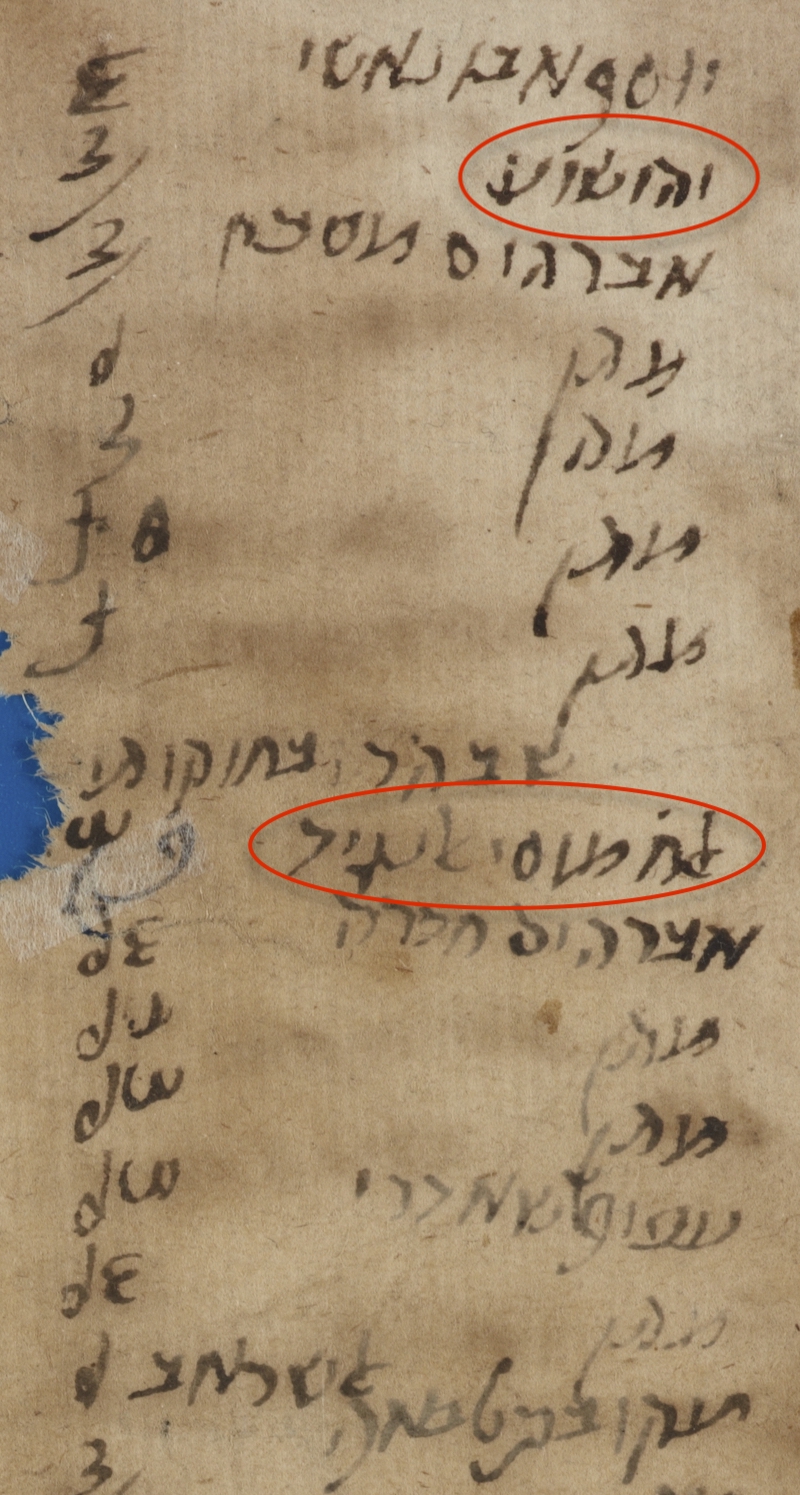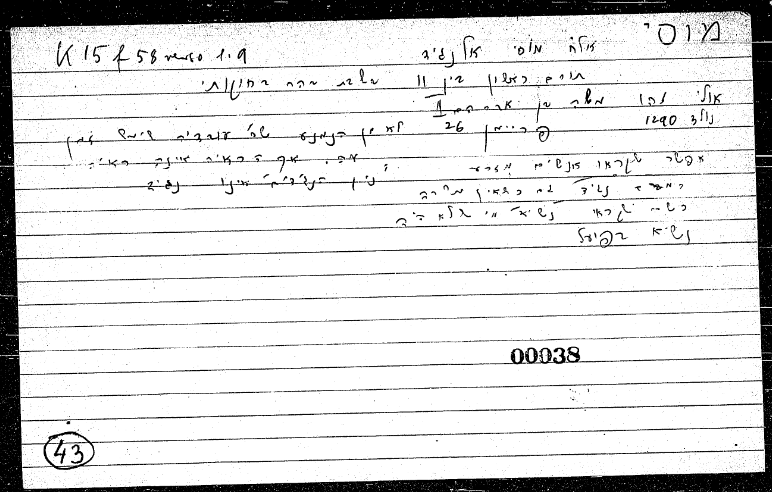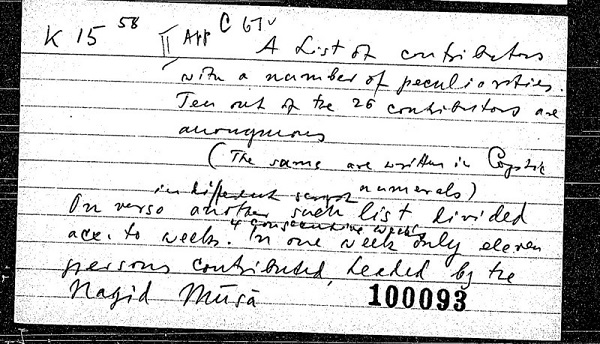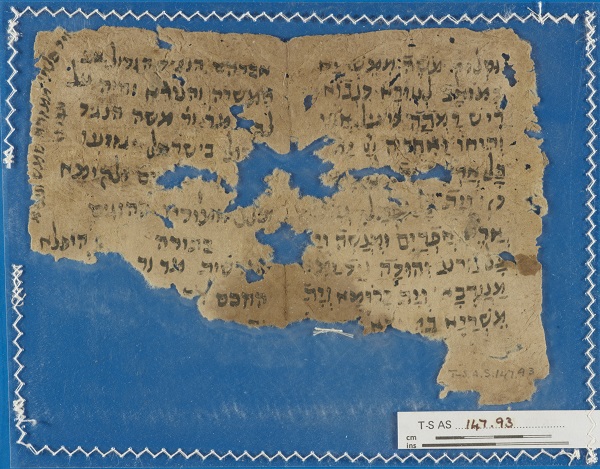Moses b. Abraham the Nagid – New evidence: T-S AS 147.93
Dotan Arad and Amir Ashur
“Everything Depends upon Luck Even the Holy Scroll in the Ark”, says a famous idiom.1 For hundreds of years the Jews of Egypt, Palestine and Syria answered to a leader known in Arabic sources as the Raʾīs al-Yahūd (“Head of the Jews”), a title that was formalised in Hebrew (from the 13th century onwards) as the Nagid. About some of these Negidim we know a significant amount, thanks to the rich data in Genizah documents, while others still remain in the dark.
Three of the Negidim bore the name Moshe. The first, Moshe b. Mevorakh, was active at the beginning of the 12th century. His Nagidate is clearly mentioned in Genizah documents, such as a torn letter where he is entitled אדוננו משה עטרת השרים חמדת הנשיאות הנגיד בעם י׳׳י אלהינו (‘our lord Moses, Crown of the Princes, Delight of the Exilarchate, the Nagid among the people of the Lord our God’; T-S Misc.28.19, unpublished). His activity as Nagid was described by Jacob Mann, Shlomo Dov Goitein and Mark Cohen. The second Moshe is known to everybody – the great eagle, Moses b. Maimon, Maimonides (he was not titled Nagid, but served as Ra’īs al-Yahūd). In comparison, so little is known about the third Moshe who served as a Nagid, Moshe b. Abraham (b. 1290), however, to whom we offer the following lines.
Our knowledge of the early period of the Maimonidean dynasty is very clear. The Nagidate (or, Riʾāsa) was passed from father to son:
1. Maimonides (d. 1204)
2. Abraham, son of Maimonides (d. 1237)
3. David, son of Abraham (d. 1300)
4. Abraham, son of David
At this point, in the fifth generation of the dynasty, the fog starts to cover our knowledge. Who was Abraham the second’s successor?
S. D. Goitein left a wonderful discussion on Joshua the Nagid (d. 1355), son of Abraham (Goitein 1985). Goitein identified a huge corpus of letters written by a certain Nagid as Joshua’s letters (although none of them was signed by him). Did Joshua take over the position of his father after his death?
Well, we do not know clearly when Abraham died. The last information about him is a document from 1316, which proves he was still alive that year (T-S 12.406, published by Ashtor, Toledot ha-Yehudim, vol. 3, doc. 44). He had three sons: Moses, Ovadya and Joshua, whom we know was a Nagid. But Joshua, who was born in 1310, was only a six-year old boy at this time. If Abraham died around 1316, it is unreasonable to assume his son Joshua was raised to power as such a small child. Scholars have asked the question: how come the youngest became a Nagid and none of the elder sons, as was customary? A. H. Freimann (1936) suggested that the two elder sons passed away, and this is the reason why the youngest son was appointed as a Nagid. We know that Ovadya died before his brother Joshua. Frieman suggested that he served as a Nagid for a short time after his father's death, and Joshua was appointed as a Nagid only after Ovadya passed away.
It seems, therefore, that between Abraham (the second) and Joshua, another family member was in the position.
Until now, we have only one mention of Moshe as Nagid: T-S K15.58, a list of donations, which mentions that אלח׳ מוסי אלנגיד (“the Ḥaver Mūsā the Nagid”) donated a sum of money on Shabbat of the portion Behar-Beḥuqqotay. In this list, a donation of one Joshua is also recorded, and maybe we can identify him with Moshe’s young brother. Of course, it is less likely that a young boy would donate money, but a donation might be given on his behalf.

Cropped section of T-S K15.58 recto
In one of his articles, Goitein was not sure about the meaning of this record:
“It is possible that [R. Joshua] the elder brother served in this position for a short period … The genizah material from the 14th century is very limited, and there is no need to wonder why we haven't found another testimony on his Nagidate especially as it was for a short term.”2
In his index card for Mūsā al-Nagid, Goitein suggested cautiously that this Mūsā “might be Mūsā b. Abraham II”.

Later on, Goitein (Mediterranean Society, vol. 2, p. 495) was more confident (following his index card to this manuscript):
“Moses was the eldest son of the Nagid Abraham II b. David b. Abraham I Maimonides. His date of birth (Nov. 1290) was known, but not the fact that he served also as Nagid, which, thus far, is testified only here.”

Mark Cohen, who published an English translation of the donations list (Voice of the poor, pp. 176–181) was also certain that we can consider this source as evidence of Moshe’s Nagidate.
However, Moshe appears on this list only with a first name, with no clear evidence for a connection to the Maimonidean dynasty. There is neither any clear proof for the date of this document (although it seems that the list was written in the Mamluk period).
So... as always happens when we visit Cambridge, things tend to pop-up. T-S AS 147.93 is a clear proof – Moshe was indeed a Nagid (ll. 3-4, משה הנגיד הגדול בישראל, ‘Moshe the Great Nagid in Israel’). The document contains a liturgical text that blesses all the component parts of Jewish society in Cairo. It starts with the Nagid and his family (ll. 1–7), continues with an unknown sage (ll. 8–9). On the verso, which is very difficult to decipher, the poet continued with other local sages/leaders (ll. 1–2), “elders and young men” (l. 3, וזקנים ובחורים). After taking “permission” (רשות) from all, he started to praise (ll. 4–5, אפתחה פי בשיר[ה] ובזמרה). Was it an introduction for a reading in the Torah in one of the festivals? Was it a special poem for any happy communal event (see verso l. 6: שהחינו וק[יימ]נו)? The bad condition of the text does not give us any ability to answer this question. However, one thing is still clear: Moses b. Abraham served indeed as Nagid and was appointed to his tenure during his father's lifetime, based on the lack of any blessing for the dead attached to Abraham’s name.

The liturgical text, T-S AS 147.93 recto
T-S AS 147.93
[0 מרשות מר׳ ור׳ …]
1 אברהם הנגיד הגדול אב
2 המשרה והנורא יחיה על
3 לב[ו?] מר׳ ור׳ משה הנגיד
4 [הג]דול בישראל יגזעו
5 [בבנים לחי]ים ולקימא3
6 וכלל חמודיו ההוגים
7 בתורה היפלא4
8 ומרשות5 מר ור [...]
9 החכם [...]
Right margin
[...י]איר פלאו ממזרח שמש ועד מ / מבואו
The world of the Negidim is being revealed step by step, document after document, more than 100 years since the formative works of Jacob Mann, through the giant leap of Goitein’s research, and continuing with many others scholars who are still deciphering new and exciting discoveries. This short fragment is one more step in our journey to a better understanding of the history of the Maimonidean Dynasty and the Jewish medieval past.
We want to thank Prof. Menahem Ben Sasson for his notes.
Amir Ashur is grateful to the Fritz Thyssen Stiftung for supporting his work on Moses Maimonides and his circle in the Cairo Genizah.
Bibliography and further reading:
E. Ashtor, Toldot Ha-Yehudim Be-Mitsrayim ṿe-Suryah Taḥat Shilṭon Ha-Mamlukim (Hebrew; 3 vols; Jerusalem, 1944).
Mark R. Cohen, The Voice of the Poor in the Middle Ages, An Anthology of Documents from the Cairo Geniza (Princeton 2005).
A. H. Freimann, “The Geneaology of Moses Maimonides’ Family”, Alummah (1936), pp. 9–32.
S. D. Goitein, “Renewal of the Dissension Concerning Recital of the Rashūt Formula” (התחדשותה של המחלוקת בענין "הרשות" אחר עליתו של רבנו אברהם בן הרמב"ם), in D. S Loewinger, S. Scheiber, and J. De Somogyi (eds), Ignace Goldziher Memorial Volume (Hebrew; 2 vols; Budapest, 1948–1958), vol. 2, pp. 49–55.
S. D. Goitein, “A Letter to Maimonides and New Sources regarding the Negidim of this Family” (מכתב אל הרמב"ם בענייני הקדשות וידיעות חדשות על צאצאיו הנגידים), Tarbiẕ 34 (1965), pp. 232–256.
S. D. Goitein, A Mediterranean Society: The Jewish Communities of the Arab World as Portrayed in the Documents of the Cairo Geniza, Vol. 2: the Community (Berkeley-Los Angeles-London, 1971).
S. D. Goitein, “The Twilight of the House of Maimonides” (דמדומי ערב של בית הרמב"ם: דמותו של ר' יהושע הנגיד ופעילותו הציבורית), Tarbiẕ 54 (1984), pp. 67–104.
S. D. Goitein and M. A. Friedman, India Book II: Maḍmūn Nagid of Yemen and the India Trade, Cairo Geniza Documents (Hebrew; Jerusalem, 2010).
S. Shtober (ed.), Sefer Divre Yosef : Ketav-yad Paris KY. Ḥ H130A (Hebrew; Jerusalem, 1981).
Footnotes
1 It is found in the Zohar, Idra Rabba 3 Parašat Naso: קָם רִבִּי אֶלְעָזָר (בריה), פָּתַח וְאָמַר, הַכֹּל תָּלוּי בְּמַזָּל, וַאֲפִילּוּ סֵפֶר תּוֹרָה בָּהֵיכָל.
2 Goitein (1965). p. 255
3 CF: T-S 10J17.25 יגזיעו בן זכר לחיים ולקי[מא]; T-S 24.55 יגזיעו גזע נכון וקיים (Published by Goitein 1958); Budapest, MTA 230.3 ואן יכלף עליה בבנים זכרים לחיים ולקימא [published in Goitein and Friedman, India Book, no. II6).
4 Maybe the word represents the whole phrase (Gen. 18:14), which has to be cited here?
5 This word appears also in the verso, l.1: ומר[שו]ת.
Cite this article
Arad, Dotan, and Amir Ashur. 2022. "Moses B. Abraham the Nagid – New Evidence: T-S AS 147.93." Taylor-Schechter Genizah Research Unit. doi:10.17863/CAM.99636.
If you enjoyed this Fragment of the Month, you can find others here.
Contact us: genizah@lib.cam.ac.uk
The manuscripts in this article are part of the Cairo Genizah Collection in Cambridge University Library. To see more items from this collection visit: https://cudl.lib.cam.ac.uk/
